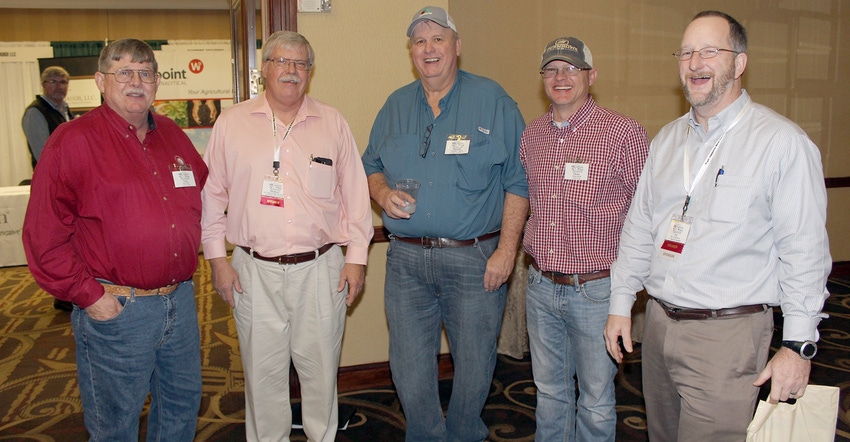
The use of precision farming technologies have become standard operating procedure for many U.S. farming operations. While the efficiencies and per-acre savings they offer have been confirmed by research and growers alike, there remain barriers to overcome operating the sometimes not-so-user-friendly technologies.
One of the cotton industry’s leading precision farming research advocates is Dr. Ed Barnes, senior director, Agricultural and Environmental Research, Cotton Incorporated. Barnes worked with a company that pioneered agricultural remote sensing technologies in the 1970s.
“I remember the difficulties we encountered with the pitch and roll of airplanes during the infancy of remote sensing research,” says Barnes. “When UAVs came on the scene, I envisioned disaster, but some of the 3D images I’m seeing are simply amazing and hold real potential for helping growers not only be more profitable, but more sustainable at the same time.”
Barnes once again moderated a precision farming roundtable discussion during this year’s Conservation Systems Conferences in Memphis, Tenn. The crowd included conservationists, landowners, bankers, researchers, a retailer steeped in sustainability, and multi-commodity row crop farmers. Some were there to absorb, and some were there looking for answers to problems they encountered using the technologies.
“I’ve seen stuff that works great on the farm, but I’ve also seen hardware or software that just doesn’t work for us,” says Neal Isbell, Ala., farmer, who, along with his son Shane, has been using variable rate fertilization for more than 20 years. “Variable rating our fertilizer is giving us the biggest return on investment right now.”
The father and son are eager to evaluate dual seed planting. Their farm’s rolling terrain presents problems they hope being able to switch from one variety to another in the same field will solve. “We’ll plant something drought-tolerant on the hills and drop a race horse variety on our bottom land,” says Isbell.
Wireless data transfer is delivering mounds of data they use to make more informed decisions. Shane writes prescriptions and is already anticipating the challenge getting his prescriptions to work when the dual seed planter arrives. “I used to carry USBs with me all the time, but wireless transfer has made it so much easier to receive and store data,” adds Shane.
Roian Atwood, director of sustainability for Wrangler Jeans spoke at the conference. He oversees a pilot sustainability program recently rolled out with a few farmers who are using precision farming technologies. Barnes told the group the work Atwood is doing is really elevating the sustainability discussion from a bunch of hyperbole to something that will actually lead to improvements.
“I’m here to see exactly how precision agriculture can help influence sustainability metrics and performance,” says Atwood.
Tiller, Ark., farmer Jacob Appleberry and his father Frank use data to define their zones. “We used variable rate to put out our lime last year and that was very beneficial, says Appleberry. “By also variable rating our pre-emerge application last year, we cut $20 an acre in herbicide costs on some of our fields.”
UAVs and data
Even though many growers understand the potential UAVs hold for ag, they want answers to questions related to when they should fly, how often they should fly, and will investing in a UAV be profitable, or is it just a cool toy?
Many roundtable attendees seemed to agree on one sentiment surrounding UAVs – “…until they can cover a lot of acres, deliver a usable image that helps me better target problem areas and bring value to the table, I’ll stay on the sidelines and wait for the technology to be more cost effective and defined.”
Dennis Burns, county agent, Tensas Parrish, La., conducts precision ag research statewide for the LSU Ag Center. “We’re flying UAVs right now and doing correlations between the aerial images we capture and the NDVI plant health readings from GreenSeeker,” says Burns. “We will take that information and write a prescription to variable rate nitrogen applications.”
Burns advises growers using aerial imagery to never take an image as gospel. One client with whom Burns worked interpreted a particular area of his field as being nutrient deficient. After inputting the location’s coordinates on his hand-held GPS, Burns walked directly to the spot in the field and was standing in water. “He didn’t have a nutrient deficiency problem, he had a drainage problem,” says Burns. “Aerial images are great to identify poor plant health, but you’ve got to put your boots in the field to more accurately determine the actual problem.”
Questions about the mounds of data created by precision farming technologies kept creeping into the roundtable discussion, and they were usually asked with a timbre of frustration.
Independent crop consultant Trent LaMastus, from Cleveland, Miss., recognizes what seems to be a universal problem with data use and storage. His grower clients often express their concerns to him. “So many growers tell me they just don’t know what to do with all the data they’re accumulating. Yield monitor data is always a point of contention because if a grower is harvesting and his yield monitor breaks, he’s not going to just stop harvesting. Then, you’ve got a broken data set, so what’s the best way to deal with that?”
With the advent of personal computers in the 80s, agricultural researchers were excited about the ability of crop simulation models to help growers make better management decisions.
“The big challenge using models back then was collecting all the data the models required, says Barnes. “Now we have almost traveled full-circle as growers struggle to find ways to capture value from the data they and their equipment collect. Listening to comments from this session convinces me that ‘artificial intelligence’ will have a role to play in agriculture much sooner than we may think.”
About the Author(s)
You May Also Like




